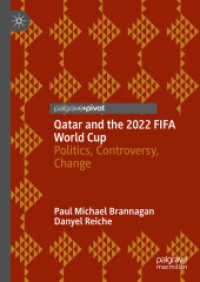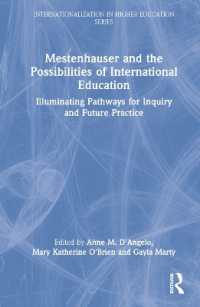- ホーム
- > 洋書
- > 英文書
- > History / World
Full Description
By the mid-twentieth century, Eastern European Jews had become one of Argentina's largest minorities. Some represented a wave of immigration begun two generations before; many settled in the province of Entre RÍos and founded an agricultural colony. Taking its title from the resulting hybrid of acculturation, The Invention of the Jewish Gaucho examines the lives of these settlers, who represented a merger between native cowboy identities and homeland memories.
The arrival of these immigrants in what would be the village of Villa Clara coincided with the nation's new sense of liberated nationhood. In a meticulous rendition of Villa Clara's social history, Judith Freidenberg interweaves ethnographic and historical information to understand the saga of European immigrants drawn by Argentine open-door policies in the nineteenth century and its impact on the current transformation of immigration into multicultural discourses in the twenty-first century. Using Villa Clara as a case study, Freidenberg demonstrates the broad power of political processes in the construction of ethnic, class, and national identities. The Invention of the Jewish Gaucho draws on life histories, archives, material culture, and performances of heritage to enhance our understanding of a singular population-and to transform our approach to social memory itself.
Contents
Foreword by June Nash
Preface: The Story behind the Story
Acknowledgments
Chapter 1. Social Memory as Part of Villa Clara's History
Chapter 2. Entre RÍos, Mi PaÍs: Immigrants Becoming Argentine in a Province
Chapter 3. Colonia Clara and the Emergence of the "Jewish Gauchos" (1892-1902)
Chapter 4. From Jewish Gauchos to Gaucho Jews: Regional Economic Development and Intercultural Relations at the End of the Nineteenth Century
Chapter 5. The Rise and Demise of Jewish Villa Clara (1902-1930s)
Chapter 6. Rural Depopulation and the Emergence of a Multiethnic and Socially Stratified Landscape in Villa Clara (1940s-1990s)
Chapter 7. The Present as Politicized Past: Legitimizing Social Structure through Heritage (1990s-2000s)
Epilogue: The Jewish Gaucho Revisited
Appendix I: Methodological Notes
Appendix II: Chronology of Relevant Events in Villa Clara
Notes
Glossary of Terms
Bibliography
Index







